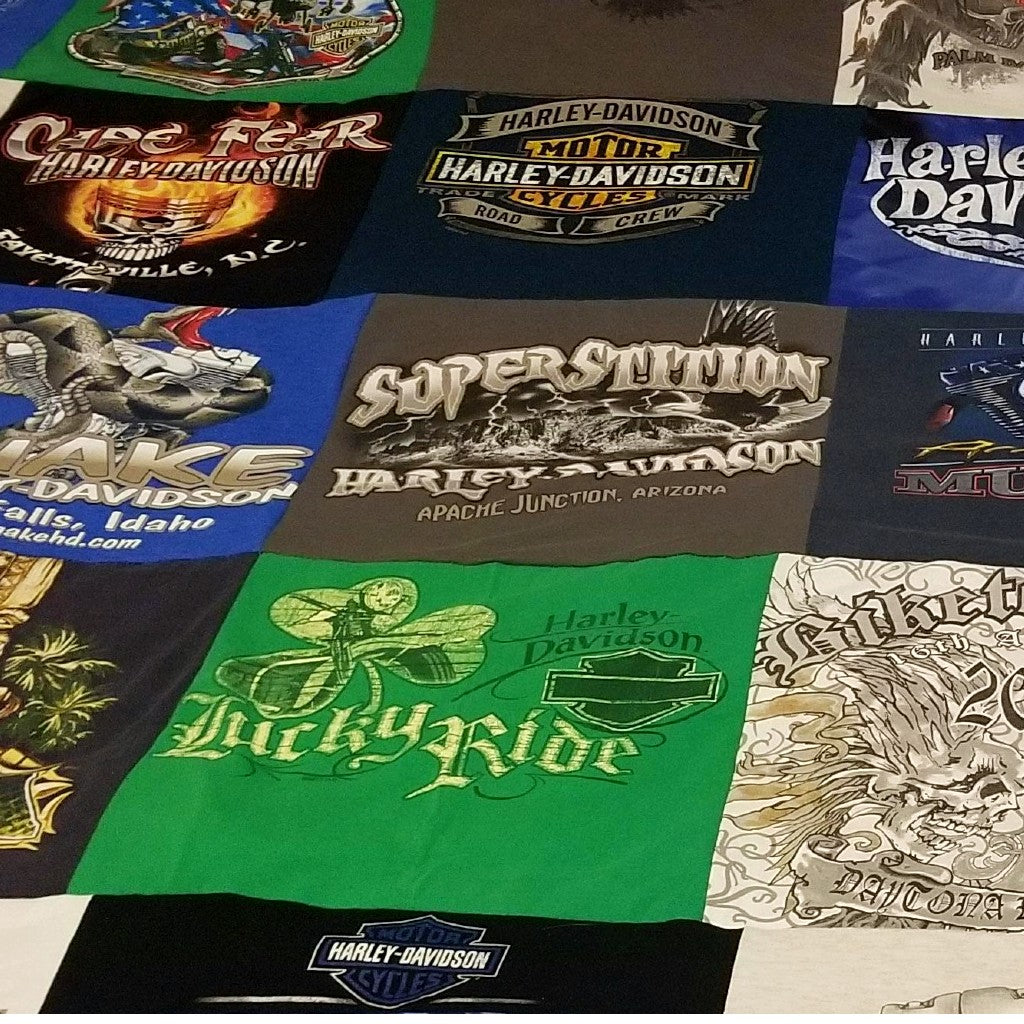Your Cart is Empty
Motorcycle t-shirts hold memories in lots of different ways for many people. However, when it comes to the point they are no longer worn, what can you do with them? Rather than just leave them in a drawer to be forgotten, you could revive these treasures by turning them into a blanket.
T-shirt blankets are relatively easy to make, but they do take a few hours, especially when it comes to arranging the motorcycle t-shirts into the best pattern. If you're making a motorcycle t-shirts blanket yourself, there are lots of ideas and panel designs you can choose from, including super simple patterns. You can also send your biker t shirts to a t-shirt blanket company that will do all of the hard work for you. The choice is yours!
However, if you're feeling crafty, there are many t-shirt blanket ideas to explore. Below we take a look at one of the easiest ways to make a blanket to capture all those memories of your favorite motorcycle t-shirts.
What you'll need to get started
Equipment and tools to make a blanket:
Materials needed to make a blanket:
The first step is to gather the t-shirts you want to use, whether that's your favorite vintage motorcycle t shirts or Honda motorcycle t shirts. Plan how many you need and consider how big they are. At this stage, decide how big you want the panels and whether they will be the same size or different sizes. Uniformed shirt quilts are typically quicker to assemble. Depending on the size of the blanket, you may also need extra fabric.
After washing and drying the t-shirts, it's time to cut the front panel. This doesn't have to be perfect straight away. Cut near the side seams and under the sleeve seams. Cut near and across the shoulder seam including the top of the sleeve in one straight cut from the shoulder seam.. This should look like a complete shirt from the front view. If you're using the back panels of your motorcycle t-shirts, it should look the same except from the back view.
Before trimming the panels:
Cut the panels in the style of your row and columns design and leave a seam allowance as before. Use your rotary cutting tools to make this step super simple.
Follow the instructions to fuse the interfacing to the back. This should be bonded securely and then trimmed to the block sizes. Don't forget to leave the seam allowance.
The next step is easier and quicker on a sewing machine but can also be completed by hand. Before sewing the fabric, pin the panels, and use your seam allowance to start sewing it together. Press the seam open and then join the rows.
After you've completed this stage, cut the backing fabric and batting to fit the design. Pin the top, batting, and backing and then sew together. The quilt binding can now be sewn onto the raw edges.
Et voila! Now you have a completed motorcycle t-shirts blanket that can be cherished for years to come.
Making a t-shirt blanket is quite simple and usually only takes a few hours to complete. However, we have a few tips and tricks to make the process even easier. Take a look at some of them below:
If you want a good-sized blanket without using too much excess fabric, opt for around 12 block or 16 block t-shirts. However, this can also depend on the size of the original t-shirt and motif panel. Of course, you can go larger or smaller depending on your preferences, and there are tons of t shirt blanket ideas using assorted panel sizes you could try for a jigsaw-style effect.
To make the sewing process as easy as possible, opt for a ballpoint needle. These are typically used in knitting techniques but can help to reduce snagging the t-shirt material compared to using a standard sewing machine.
If you're new to sewing and have never attempted making a t-shirt blanket before, it might seem overwhelming. However, this type of sewing is a great place to start, especially if you want to get into other craft hobbies.
Before you design and start the process of a larger blanket, practice with a smaller design first. Use fabric scraps or old t-shirts you don't want to keep and create a mini blanket with these panels. This will give you an idea of the type of snags you might come up against before starting the real thing.
There are many different fabrics that can be used for these sections of the blanket. Still, it's often best to avoid polyester. Polyester doesn't wash as well as cotton, and batting in this material fiber could poke through the back of your blanket.
To ensure the quality and look of your blanket stays in excellent condition, make sure the backing fabric is prewashed. This material might shrink or fade in color after a few washes, which could affect the seam stitching and appearance of the blanket.
If you have everything ready to get started, these tips will help guide you through the blanket making process. However, creating a blanket seems daunting; there are lots of companies that can help make your old t-shirts into a cherished memory.
Comments will be approved before showing up.
